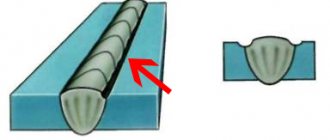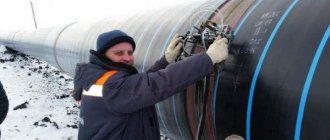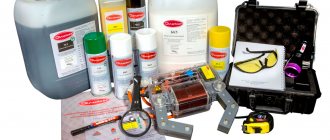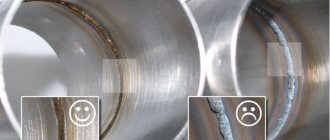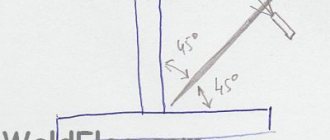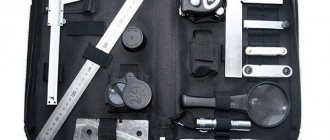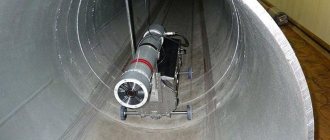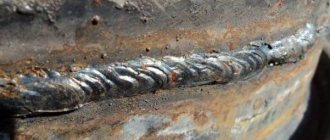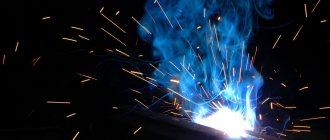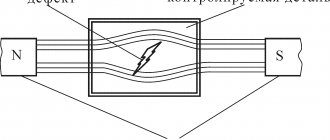Types of weld defects
All tolerances on weld dimensions are regulated by GOST requirements for each type of welding. Any deviations of the readings from the approved standards are considered to be defects. They can be a consequence of errors in the process of both preparation and execution of welding work.
Most defects in a welded joint have a negative impact on its strength characteristics. All defects are divided into three groups:
- external _ The main indicators are irregular joint shape, cracks, sagging, craters, seam undercuts, burns and other visual signs that can be detected on the surface. They are visible upon careful visual inspection and only a few can be noticed at first glance;
- internal . Defects are incomplete or uneven fusion of metals, cracks or porosity in the structure, the presence of foreign inclusions - slag, oxide, non-metallic impurities; other flaws located inside the seam;
- end-to- end Cracks, undercuts, burns and other damage that are end-to-end and visible on both sides.
Any defects are grounds for rejection of the work and must be corrected. This rule is especially relevant for supporting metal structures - frames, frames, sheathing, etc. They must be welded flawlessly to withstand the expected loads. Otherwise, the structures may become a source of danger to others.
Classification of defects in welded joints
Not in every case is it possible to achieve ideal quality of the welded joint. If desired, you can find deviations from the established requirements. The full classification of welded joints is set out in paragraphs of GOST 30242-97. The document contains information about all possible flaws. Of these, we can highlight some that are most often encountered during control inspection of connecting joints.
Cracks
Cracks have the greatest negative impact on the quality of the weld. Potentially, they are the most dangerous, since they can cause rapid destruction of the entire structure, which in turn can lead to tragedy.
Cracks appear for various reasons:
- the joints are positioned incorrectly;
- the welding site was sharply cooled;
- incorrectly selected consumables;
- the metal crystallized due to excessively high temperature.
Based on the method of formation, cracks can be longitudinal, transverse or radial, and based on size, it is customary to distinguish between macro- and microcracks. Regardless of the type, causes and method of formation, a crack is an unacceptable defect.
Undercuts
Visually, the flaw is a longitudinal depression on the outer part of the seam. Due to the undercut, the cross-section of the seam is reduced and internal joint stress is generated. The strength of such a seam is highly questionable. The main reason for the formation of a defect is an overestimated welding current. Most often, undercuts are characteristic of horizontal seams.
Surges
Excess melt flows onto the surface of the workpiece, cools and forms a false bead. This is an influx that does not have strong fusion with the working surface. Most often, a defect is formed during horizontal welding of butt or fillet welds. The reason for their formation is insufficient heating of the base metal, due to excess filler material or scale on the edges of the mating surfaces.
Burns
A flaw is a through hole that is formed due to metal leaking out of the weld pool. As a rule, an influx forms from the reverse side. Burn-through is caused by too slow movement of the electrode along the joint line, too much current, insufficient thickness of the gasket or its loose fit, or a large gap between the parts.
Lack of penetration
If there are areas between the seams and the base metal where lack of fusion between them is visible, then this is a lack of fusion. That is, the base metal did not warm up properly to form a single whole with the melt. Such a defect greatly reduces the strength characteristics of the connection and the entire structure as a whole. The reason for lack of penetration may be too high a speed of movement of the electrode, poor preliminary preparation of the edges, the presence of scale, rust and other contaminants on the surface of the workpieces being joined.
Craters
Small depressions in the weld bead are formed as a result of a break in the welding arc. Defects lead to a reduction in the cross-section of the joint, which reduces its strength. The secondary danger of the crater is that its bottom may have additional loose inclusions, leading to the appearance of cracks.
Fistulas
Flaws are surface defects in the form of cavities. They reduce the strength of the joint and are additionally dangerous because they can provoke the formation of cracks. Fistulas are characterized by an arbitrary shape and can form both on the outside and on the inside.
Pores in the weld
Gas-filled pores may form during the welding process. The reason for their occurrence is various contaminants on the surface of the workpiece, high speed of electrode movement, and too high carbon content in the filler material.
Foreign inclusions
The quality of the weld is significantly reduced due to foreign inclusions - slag, flux, oxide, tungsten and others. The main reason that causes them is an incorrectly selected welding mode.
Pores: their shape, location and reasons for their appearance
Defects in welded joints and joints in the form of cavities in a welded joint are called pores. These cavities are filled with gas that has not had time to escape.
The following types of pores are distinguished:
- A gas cavity is a formation of arbitrary shape, has no corners, the cause of which was gases that did not have time to leave the molten material.
- A gas cavity is sometimes called a gas cavity and has a spherical shape.
- A group of gas pores located in the metal of a welded joint is called uniformly distributed porosity.
- A cluster of pores is three or more gas cavities located closely at a distance from each other, not exceeding triple the diameter of the maximum pore.
- A chain of pores is a series of gas cavities that are located in a line along the welded joint with a distance between them that does not exceed three diameters of the longest time.
- If the defect is not continuous, extends along the axis of the weld and has a height that is much less than the length, then it is called an oblong cavity.
- A fistula is a tubular cavity located in the weld metal. A fistula is caused by the release of gas. Its shape and position are determined by the gas source and the hardening regime. As a rule, fistulas form clusters in the shape of fir trees.
- A gas cavity that violates the integrity of the surface of the welded joint is called surface time.
- If a cavity forms during hardening due to shrinkage, it is called a shrinkage cavity. A shrinkage cavity located at the end of the roller and not welded during subsequent passes is called a crater.
Time - defects in welded joints, photos of which are given below, appear due to the presence of harmful impurities, both in the base metal and in the filler metal. Time stains can form due to rust and other contaminants that were not removed from the edges of the material before welding, high carbon content, high speed of the welding process, and violations of the weld pool protection. The most common cause of pores is a damp coating melting the electrode.
The presence of single pores does not pose a danger, but their chain can negatively affect the strength of the welded joint. section of the weld, shocked by these defects, is digested, having previously mechanically cleaned it.
Time and slag inclusions
Causes of weld defects
Any defect is formed due to a certain factor. There are different reasons for the formation of weld defects:
- During the work, low-quality consumables were used;
- the technology for performing welding work was not followed;
- low quality metal used to create the welded structure;
- equipment malfunction or poor quality work;
- incorrectly selected welding mode;
- technological errors were made due to the low qualifications of the specialist.
To obtain a high-quality metal structure, strict adherence to technological parameters and welding standards is required, and specialists with a sufficient level of qualification are involved in the work.
What is called inclusion in welding?
The absence of joint defects during fusion welding of metals is the only guarantee of the reliability of welded joints. Defects in welds reduce the strength and operational reliability of welded joints and can lead to destruction of the entire structure.
The causes of defects in welds are violations of the technological process during preparation, assembly, welding, heat treatment of connected units, as well as negligence and low qualifications of the welder.
The classification of defects is given in the interstate standard GOST 30242-97 “Defects in joints during fusion welding of metals. Classification, designations and definitions."
OTHER DEFECTS
Other defects include: stray arc, metal spatter, tungsten spatter, surface scoring, metal thinning and other defects.
Accidental arc – damage to the base metal resulting from accidental arcing (short circuit of the electrode to the base metal).
Metal spatter is a defect in the form of hardened droplets on the surface of a weld or base metal formed during welding. The reasons for this defect are: excessive welding current, poor-quality electrode coating, lack of protective coatings that ensure easy removal of spatter after welding.
Surface scoring is damage to the surface due to the removal of a temporarily welded fixture.
Uneven seam width, uneven surface - discrepancy between the geometric dimensions of the seam and the required ones. A defect appears due to unstable welding mode and inaccurate direction of the electrode.
Defect detection methods
Various methods are used to identify weld defects:
- joint measurements and visual inspection;
- checking connections for leaks;
- searching for defects using special instruments;
- laboratory tests of samples for strength.
Visual determination of the quality of the weld is carried out only after thoroughly cleaning its surface from slag, eliminating various contaminants and frozen metal spatters. The dimensions, shape, and presence of defects are checked - burns, fistulas, cracks, craters and other flaws.
Thanks to leakage tests, it is possible to determine the presence or absence of pipeline defects - pores, cracks, lack of fusion. The tightness of the structure is checked in the following ways:
- air blowing;
- filling with water under pressure;
- kerosene treatment.
If a defect is detected, additional processing is required to eliminate it.
How to identify defects in a weld
External defects are detected visually, and internal ones - by destructive and non-destructive testing methods. The first include bending tests (which are carried out after complete removal of the flash) and determination of the impact strength of the joint, and the impact location is taken at a distance of 15...20 mm from the welded joint. Hardness measurement is also often used at a distance of 3...5 mm from the joint; it should not be higher than 285 HB.
Of the non-destructive testing methods, ultrasonic flaw detection is most often used.
Methods for eliminating defects in welded joints
Regardless of the equipment involved - inverter, classic device, transformer, etc. - the formation of defects is not excluded. It is customary to distinguish between so-called acceptable and unacceptable welding defects. Depending on the type and complexity of the defects, the suitability of the finished product for use is determined.
Designs that are not approved for use are sent for revision. How the defect will be eliminated depends on the type of defect:
- the burn is welded after thoroughly cleaning the welded joint;
- undercuts are eliminated by applying a thin overlay along the entire length of their formation;
- the area with the crack is drilled out, the body of the seam is cut out, the surface is cleaned and degreased. After this, the recess is welded;
- incomplete brews are cut out and re-brewed;
- fistulas and craters are eliminated using the same scheme. First of all, everything is cut down to the base metal. After this, the joint is welded in a new way;
- the sagging should be carefully cut off, checking for any lack of penetration;
- deformed areas are leveled by heating or mechanically;
- any of the defects, implying the presence of foreign inclusions, is eliminated by cutting out the seam (section) and applying a new one.
If during the inspection process defects in the technological nature of pipe connections are discovered, correction is carried out using one of the following methods:
- mechanically without welding;
- mechanically in combination with welding of the defective area;
- cutting out a section of the pipeline containing a technological defect;
- the seam is completely removed and the joint is welded in a new way.
The strength and tightness of gas supply networks is restored by arc welding. The use of gas welding installations is not permitted.
Lack of fusion and lack of penetration: causes
Defects - lack of fusion and lack of fusion - are the lack of connection between the base material and the metal of the welded joint.
Non-fusion occurs at high speeds of the welding process and current strengths of more than 15000C. To prevent non-fusion, it is necessary to reduce the welding speed, reduce the time gap between the formation and filling of the groove, and thoroughly clean the welding area from oils and contaminants. Non-fusion can be located:
- at the root of the weld;
- on the side;
- between the rollers.
Lack of penetration occurs due to the inability of the molten metal to reach the root of the weld. There may be several reasons for lack of penetration:
- insufficient welding current;
- electrode movement speed is too high;
- increased arc length;
- the bevel angle is too small;
- distortion of welded edges;
- insufficient gap between edges;
- incorrectly selected – increased – electrode diameter.
- slag getting into the gaps between the edges;
- inadequate choice of polarity for this type of electrodes.
Lack of penetration is a very dangerous and unacceptable welding defect.
If you often make barbecues, then a grill that you can make yourself will be useful to you. Detailed instructions in this article.
Don't know what you need for gas welding? Detailed list of required materials at https://elsvarkin.ru/materialy/materialy-dlya-gazovoj-svarki/ link.
Methods for monitoring welded joints
It goes without saying that any defects in the welded joint increase the risk of structural failure. To minimize this likelihood, the quality of welded joints should be carefully checked. The whole process is carried out in stages:
- preliminary. The quality of metal and consumables is checked;
- control during welding work. The welding mode and equipment operation are constantly checked, seams are inspected and measured. In cases where deviations from standards are discovered, the defects are immediately corrected;
- acceptance of the finished structure. Visual inspection determines the presence of external defects. If necessary, laboratory and test checks are carried out.
Control methods used today are divided into two groups - non-destructive and destructive. To identify defects in finished structures, non-destructive testing methods are usually used:
- visual inspection;
- Ultrasound inspection (flaw detection);
- control using a magnetic field;
- color flaw detection;
- radiation flaw detection;
- capillary flaw detection;
- permeability control;
- other methods.
Destructive testing is used on samples selected for this purpose. It allows you to set the parameters of the weld strength and heat-affected zone. The control involves chemical, mechanical and metallographic testing methods.
Methods for detecting, monitoring and eliminating defects
To detect weld defects, the following methods are used:
- visual inspection - carried out using magnifying devices;
- color flaw detection - based on a change in the color of a special material upon contact with a fluid material, for example, kerosene;
- magnetic method - measuring the distortion of magnetic waves;
- ultrasonic method - the use of ultrasonic flaw detectors that measure the reflection of sound waves;
- radiation method - X-raying welds and obtaining an image with all the details of the defect.
To ensure the quality of the weld, marking and branding are carried out. Each welder puts his mark on his welding area.
If a defect is detected, it is necessary to eliminate welding defects. For this, the following types of work are used:
- welding - used to eliminate large cracks, having previously prepared the crack by drilling and cleaning with a chisel or an abrasive tool;
- internal small cracks, lack of fusion and inclusions must be completely cleaned or cut out with re-welding;
- incomplete seams and weld undercuts are eliminated by surfacing or welding in thin layers;
- Sagging is removed mechanically using an abrasive tool;
- Overheating of the metal is eliminated by heat treatment.
The formation of internal defects during welding is associated with metallurgical, thermal and hydrodynamic phenomena that occur during the formation of the weld.
Internal defects include cracks (hot and cold), lack of penetration, pores, slag tungsten and oxide inclusions. These six main types of defects should be distinguished in accordance with GOST 23055-78. They also coincide with the main groups of defects according to the CMEA standardization recommendations RS 2192-82.
Cracks
— weld defects, which are macroscopic and microscopic intercrystalline destruction, forming cavities with a very small initial opening. Under the influence of residual and operating stresses, cracks can propagate at high speeds. Therefore, the brittle fractures they cause occur almost instantly and are very dangerous.
Depending on the temperature at which they occur, hot and cold cracks are distinguished.
Hot cracks
represent destruction of crystallizing metal that occurs along liquid layers under the action of tensile stresses. These stresses appear due to the non-free shrinkage of the weld metal and the unevenly heated areas of the base metal adjacent to it.
Read also: Do-it-yourself lug lugs for a car
The formation of hot cracks is associated with the combined action of two factors. As crystallization proceeds, the amount of liquid phase decreases, which leads to a decrease in the deformability of the alloy. In addition, in the temperature range of brittleness (TER), the plastic properties of the alloy are the lowest. Crystallization cracks are formed if the plastic deformation during the stay of the metal in the TIC exceeds the plasticity of the alloy in this temperature range.
Characteristic of hot cracks is an intergranular type of fracture that develops along grain boundaries in the presence of a liquid layer between them or due to intergranular slippage that occurs at elevated temperatures after the end of the crystallization process.
Hot cracks
can occur both in the base metal and in the metal of the heat-affected zone. They can be longitudinal, transverse, longitudinal with transverse branches, they can come to the surface or remain hidden. The probability of the formation of hot cracks depends on the chemical composition of the weld metal, the rate of increase and magnitude of tensile stresses, the shape of the weld pool and seam, and the size of primary crystallites. It increases with increasing content of carbon, silicon, nickel, harmful impurities of sulfur and phosphorus in the weld metal. Manganese, chromium and partly oxygen contribute to increasing the resistance of welds and the formation of hot cracks, as well as reducing the magnitude and rate of increase in tensile stresses, which is achieved by reducing the rigidity of the units, using a welding method with an optimal thermal cycle, for example, welding with PPM (grit), using special technological methods, such as preheating, etc. The influence of the weld shape coefficient on the probability of hot cracking is not clear. When the weld shape coefficient is less than 1.8 and more than 10, the resistance to hot cracking decreases even at a relatively low carbon content.
Cold cracks
are formed most often in the heat-affected zone, less often in the weld metal of welded joints of medium-alloy and high-alloy steels of pearlitic and martensitic classes. The appearance of cold cracks is explained by a complex of reasons. One of them is the influence of high internal stresses arising in connection with the volumetric effect accompanying the martensitic transformation, which occurs under conditions of reduced metal ductility. Therefore, cold cracks are observed both at decomposition temperatures of retained austenite (120 °C and below) and at room temperature several minutes, hours, and sometimes even longer after welding. High internal stresses can also develop due to the adsorption of hydrogen dissolved in the metal on the surfaces of internal defects and its accumulation in micro-discontinuities. The occurrence of cold cracks is also associated with delayed destruction of the metal under the action of stresses, which, according to the Zener scheme, accumulate along grain boundaries perpendicular to the direction of action of normal stresses.
Lack of penetration
- these are areas of the welded joint where there is no fusion between the parts being welded, for example, at the root of the weld, between the base and deposited metal (along the edge) or between adjacent layers of deposited metal.
The surfaces of lack of fusion are usually covered with thin oxide films and other contaminants. Very often, cavities formed by lack of penetration are filled with slag. Ends of lack of penetration in weld metal
or at the fusion boundary, as a rule, have a very small opening. Lack of penetration reduces the working section of the weld ,
which can lead to a decrease in the performance of the welded joint. Being stress concentrators, lack of fusion can cause cracks, reduce the corrosion resistance of the welded joint, and lead to corrosion cracking.
Lack of penetration can be caused by many reasons: a small angle of opening of the edges, a small gap, a large dullness with insufficient current; high welding speed; displacement of the electrode from the axis of the seam, especially when welding double-sided seams; poor slag cleaning before applying subsequent layers; excessive amount of PPM with insufficient current strength at high welding speed; low qualification of the welder.
Lack of penetration is a very dangerous welding defect.
Pores are
cavities in the weld metal filled with gases. They usually have a spherical or similar shape. Standard welds in carbon steels often have a tubular shape. Initially, having arisen in the liquid metal of the weld due to intense gas formation, all gas bubbles manage to rise to the surface and escape into the atmosphere. Some of them remain in the weld metal. The sizes of such pores range from microscopic to 2.3 mm in diameter, and due to the diffusion of gases (primarily hydrogen) they can grow. Shells are formed (cavities of irregular shape and larger than the pores), as well as fistulas that come to the surface. In addition to single pores caused by the action of random factors, pores may appear in welds, evenly distributed over the entire cross-section of the seam, arranged in the form of chains or individual clusters.
The main reasons causing the appearance of pores include: poor cleaning of welded edges from rust, oils and various contaminants; increased carbon content in the base or filler metal, high welding speed, at which gas evolution does not have time to pass through and pores remain in the weld metal: high humidity of electrode coatings, flux, welding in bad weather.
Slag inclusions
- these are cavities in the weld metal, filled with slag that does not have time to float to the surface of the weld. Slag inclusions are formed at high welding speeds, with heavy contamination of the edges and during multi-layer welding in cases of poor cleaning of slag from the surface of the seams between layers. The dimensions of slag inclusions can reach several millimeters in cross section and tens or more millimeters in length. The shape of slag inclusions can be very diverse, as a result of which they are more dangerous defects than round pores.
Tungsten inclusions
may appear in the weld metal during argon arc welding with a non-consumable electrode, for example, aluminum alloys in which tungsten is insoluble. Tungsten particles that fall into the molten weld pool due to regime instability are usually immersed in it due to its high density. On X-ray photographs, tungsten inclusions appear as clearly visible light spots of irregular shape, located separately or in groups.
Oxide inclusions
- can occur in weld metal in the presence of sparingly soluble oxides, for example Al2Oe, at high rates of crystallization of the weld. Arranging in the form of films, they form discontinuities in the weld metal with a small opening and their adverse effect on the mechanical properties of welds can be stronger than pores and slag inclusions [12].
